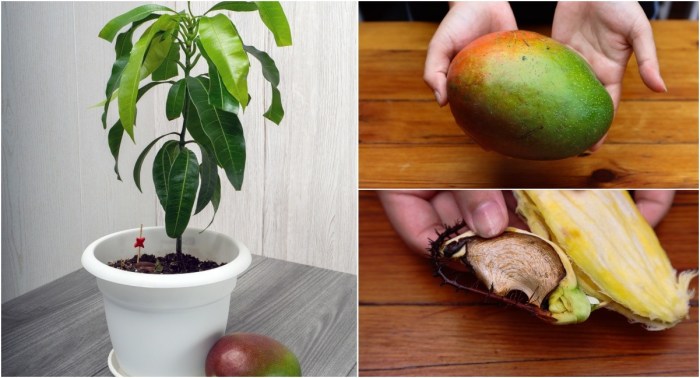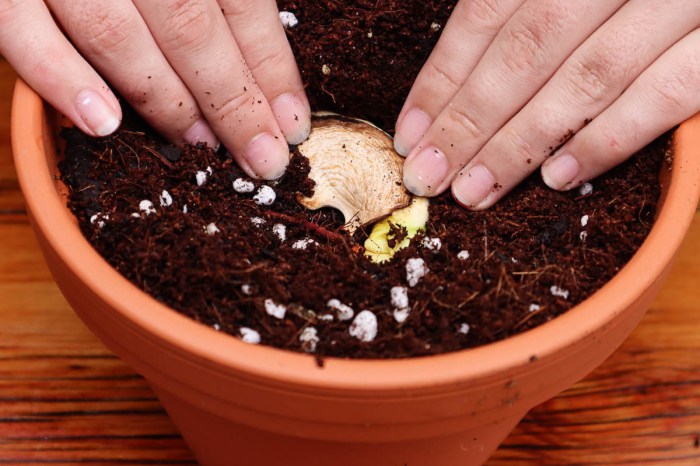How to Plant Mango Seeds A Step-by-Step Guide
Selecting Mango Seeds for Planting
How to plant mango seed – Choosing the right mango seed is crucial for successful germination and a healthy, productive tree. The seed’s condition significantly impacts its ability to sprout and develop into a strong seedling. Selecting viable seeds and handling them carefully will increase your chances of a thriving mango tree.
Ideal Characteristics of a Mango Seed
A healthy mango seed is plump, firm, and free from blemishes or signs of damage. It should be a rich, dark brown color, indicating maturity. Avoid seeds that are shriveled, cracked, discolored, or show signs of mold or insect infestation. These characteristics suggest a lack of viability and a low probability of germination. The size of the seed is less important than its overall condition; a smaller but healthy seed is preferable to a larger, damaged one.
Extracting Mango Seeds from the Fruit
Carefully cut open a ripe mango, avoiding damage to the seed. Locate the large, flat seed within the fruit’s central cavity. Gently remove the seed, taking care not to bruise or scratch its surface. Rinse the seed under running water to remove any remaining fruit pulp. Avoid scrubbing or excessive force, which can compromise the seed’s integrity and reduce its germination potential.
After rinsing, allow the seed to air dry completely before proceeding to viability assessment.
Assessing Seed Viability
Before planting, assess the seed’s viability to determine its likelihood of germination. One method involves carefully examining the seed’s exterior for any signs of damage, as mentioned earlier. Another way to check viability is the float test. Place the seed in a container of water. Viable seeds will typically sink, while those that float are likely non-viable and should be discarded.
Remember that even if a seed sinks, it does not guarantee germination, but it increases the probability. The float test provides a quick and easy way to eliminate seeds with little chance of success, saving time and resources.
Preparing the Mango Seed for Germination

Proper preparation of mango seeds significantly impacts their germination success. A well-prepared seed has a higher chance of sprouting and developing into a healthy seedling. This involves techniques aimed at overcoming the seed’s natural dormancy and creating optimal conditions for root and shoot emergence. Several methods can be employed, each with varying degrees of effectiveness.
Mango Seed Soaking Methods
Soaking mango seeds in water helps to soften the hard seed coat, allowing for easier water absorption and the initiation of germination. Different soaking durations and water treatments can be employed. For example, soaking seeds in plain water for 24-48 hours is a common practice. Some growers also advocate for soaking seeds in warm water (around 100-110°F) for shorter periods to stimulate germination.
The optimal soaking time depends on the seed’s age and condition. Older seeds may require longer soaking times. It’s important to monitor the seeds during soaking and remove any that show signs of decay or damage.
Mango Seed Scarification Techniques
Scarification involves artificially weakening or breaking the seed coat to facilitate germination. This is particularly useful for mango seeds, which have a relatively hard and impermeable outer layer. Several scarification methods exist. One common technique involves gently filing or sanding a small portion of the seed coat to create a crack. Another method involves using a sharp knife or blade to carefully nick the seed coat.
Care must be taken not to damage the embryo inside the seed. The effectiveness of scarification varies depending on the seed’s hardness and the extent of the scarification. Over-scarification can harm the seed and reduce its viability.
Comparing Seed Preparation Methods
While both soaking and scarification can improve germination rates, their effectiveness varies depending on several factors, including the seed’s age, variety, and environmental conditions. Soaking alone may be sufficient for some seeds, particularly those with relatively thin or already cracked seed coats. However, for seeds with hard coats, scarification is often necessary to break the dormancy and allow water absorption.
Combining soaking and scarification can further enhance germination rates. For example, soaking the seeds for 24 hours followed by gentle scarification has shown promising results in several studies. The optimal approach depends on the specific characteristics of the seeds and the grower’s experience.
Importance of Proper Seed Preparation for Germination
Proper seed preparation is crucial for maximizing germination rates and producing healthy mango seedlings. By overcoming the natural dormancy of the seed, proper preparation allows for faster and more consistent germination. This translates to higher seedling survival rates and ultimately, a greater chance of successful mango tree establishment. Without proper preparation, many seeds may fail to germinate, leading to wasted effort and resources.
The time invested in seed preparation is a small price to pay for the potential increase in germination success and the resulting benefits.
Planting the Mango Seed: How To Plant Mango Seed

Planting a mango seed requires careful attention to detail to maximize the chances of successful germination and growth. The success of your planting depends on several factors, including the quality of the seed, the preparation methods used, and the environment you provide for the seedling. Following these steps will increase your likelihood of a healthy mango tree.
Direct Sowing
Direct sowing involves planting the prepared mango seed directly into its final growing location. This method is suitable for areas with consistently warm and humid climates and well-drained soil. Choose a location that receives ample sunlight (at least six hours per day) and is protected from strong winds. Before planting, loosen the soil to a depth of about 12 inches to ensure good drainage and root penetration.
Growing mangoes from seed involves selecting a ripe mango, cleaning the seed, and planting it in well-draining soil. Understanding the right conditions is crucial, much like knowing the various names for the rubber tree plant name , which also requires specific environmental factors for optimal growth. Consistent watering and sunlight are key to successful mango cultivation, ensuring healthy germination and eventual fruiting.
Dig a hole approximately 1-2 inches deep, depending on the size of the seed. Place the seed horizontally with the pointed end facing upwards, and cover it gently with soil. Water the area thoroughly after planting. Maintain consistent moisture levels, avoiding both waterlogging and drought.
Planting in a Seed Tray
Starting mango seeds in a seed tray offers more control over the germination process, especially in areas with less favorable conditions. Seed trays provide a controlled environment that promotes consistent moisture and warmth. Fill the seed tray with a well-draining seed-starting mix. Plant the prepared mango seed about 1 inch deep and 2-3 inches apart. Gently firm the soil around the seeds.
Water the tray thoroughly and place it in a warm location with indirect sunlight. Maintain consistent moisture by regularly checking and watering as needed, ensuring the soil remains moist but not soggy. Once the seedlings have developed a few true leaves (typically after several weeks), they can be carefully transplanted into individual pots or directly into the ground.
Depth and Spacing
Imagine a diagram showing two rows of holes in the ground. Each hole is about 1-2 inches deep, marked by a small wooden stick next to it. The holes are spaced approximately 6-12 inches apart within a row, and the rows are spaced 1-2 feet apart, depending on the available space. The depth ensures the seed is covered adequately while allowing for easy germination.
The spacing provides enough room for the roots and leaves to develop without competition. This visual helps understand the appropriate depth and spacing necessary for healthy mango tree growth. The depth marker (a small stick) provides a clear visual cue for maintaining consistent planting depth. The spacing between seeds ensures each seedling has sufficient space for growth. Using a ruler or measuring tape to ensure proper spacing during planting will assist in achieving ideal spacing.
Caring for the Mango Seedling
Nurturing a young mango seedling requires consistent attention and care to ensure its healthy growth and development. Providing the right conditions for water, nutrients, and overall environment is crucial for the seedling’s survival and eventual flourishing into a mature mango tree. This section details the essential aspects of caring for your mango seedling.
Watering Schedule for Mango Seedlings
The frequency of watering depends significantly on the climate and soil type. In hot, dry climates, more frequent watering is necessary, perhaps daily or every other day, especially during the seedling’s early stages. Conversely, in humid or cooler climates, less frequent watering may suffice, potentially every 2-3 days or even weekly. Well-draining soil is essential; it prevents waterlogging, which can lead to root rot.
Clay soils retain more moisture, requiring less frequent watering compared to sandy soils, which drain quickly and need more frequent irrigation. Observe the soil moisture; if the top inch feels dry, it’s time to water. Avoid both overwatering and underwatering. A consistently moist but not soggy soil is ideal.
Identifying and Addressing Watering Issues
Overwatering manifests as yellowing leaves, wilting, and stunted growth, eventually leading to root rot. The soil will remain consistently damp or soggy. Underwatering, on the other hand, causes the leaves to droop, turn brown and crisp at the edges, and the overall plant to appear withered. The soil will be dry to the touch, even several inches down.
To address overwatering, reduce watering frequency and improve soil drainage if necessary (e.g., amending clay soil with organic matter). For underwatering, increase watering frequency and ensure deep watering to reach the roots.
Essential Nutrients and Fertilizers, How to plant mango seed
Mango seedlings benefit from a balanced supply of essential nutrients. A well-balanced fertilizer, such as a 10-10-10 formulation (N-P-K), provides a good starting point. Nitrogen (N) promotes leaf growth, phosphorus (P) aids root development, and potassium (K) contributes to overall plant health and disease resistance. Other important micronutrients include iron, zinc, and manganese, which can be supplemented through specialized fertilizers or soil amendments if deficiencies are observed.
The application method depends on the type of fertilizer. Granular fertilizers can be applied around the base of the plant, while liquid fertilizers can be diluted and applied directly to the soil or as foliar sprays. Always follow the manufacturer’s instructions carefully to avoid over-fertilizing, which can damage the seedling. Avoid applying fertilizer directly to the stem.
Transplanting the Mango Seedling

Transplanting a mango seedling is a crucial step in its development, moving it from its initial germination environment to a larger space allowing for robust root and shoot growth. The timing and method of transplanting directly impact the seedling’s survival and future health. Careful consideration of these factors ensures the young tree thrives.The optimal time to transplant a mango seedling is during the warm, wet season, typically after the risk of frost has passed.
This period provides ideal conditions for the seedling to establish itself in its new environment. Specifically, this often falls within the late spring or early summer months, depending on your geographic location and climate. Transplanting during this time minimizes stress on the plant and allows it to focus on growth rather than survival. Avoid transplanting during periods of extreme heat or drought, as this can lead to transplant shock and potentially kill the seedling.
Optimal Transplanting Time
The best time for transplanting is during the warm, wet season, after the last frost. This typically falls between late spring and early summer, providing optimal conditions for root establishment and minimizing stress on the young plant. Choosing this period maximizes the seedling’s chances of successful transplantation and healthy growth. Monitoring weather patterns and soil moisture levels is crucial for determining the ideal planting window.
Transplanting Procedure
Preparing the new location is vital. If planting directly into the ground, ensure the soil is well-drained and rich in organic matter. Dig a hole significantly larger than the root ball of the seedling, allowing ample space for root expansion. For larger containers, select one with sufficient drainage holes to prevent waterlogging. Gently remove the seedling from its current container, taking care not to damage the roots.
If roots are circling, gently loosen them to encourage outward growth. Place the seedling in the new hole or container, ensuring the top of the root ball is level with the surrounding soil. Backfill with soil, gently firming it around the base of the seedling to eliminate air pockets. Water thoroughly after transplanting to settle the soil and provide the seedling with much-needed moisture.
Hardening Off Mango Seedlings
Before transplanting a mango seedling outdoors, a process called “hardening off” is essential. This gradually acclimates the seedling to the outdoor environment, reducing the risk of transplant shock. Start by placing the seedling in a shaded area for a few hours each day, gradually increasing the exposure to sunlight over a period of about a week. This allows the seedling to adjust to the stronger sunlight, wind, and temperature fluctuations of the outdoor environment.
Simultaneously, reduce watering slightly to encourage deeper root growth. Once the seedling shows signs of adapting to the outdoor conditions, it is ready for transplanting. This gradual transition minimizes stress and enhances the chances of successful establishment.
Protecting the Mango Seedling from Pests and Diseases
Protecting young mango seedlings from pests and diseases is crucial for their survival and healthy growth. A healthy seedling is more resilient and has a higher chance of developing into a productive mango tree. Early intervention is key to preventing significant damage and ensuring a thriving plant.
Common Pests and Diseases Affecting Mango Seedlings
Mango seedlings are susceptible to a range of pests and diseases, many of which can severely stunt growth or even kill the plant. Early identification is crucial for effective management. Some common pests include aphids, mealybugs, scale insects, and spider mites. These insects feed on the sap of the plant, weakening it and potentially transmitting diseases. Common diseases include anthracnose, powdery mildew, and root rot.
Anthracnose causes leaf spots and fruit rot, while powdery mildew coats leaves with a white, powdery substance, hindering photosynthesis. Root rot, as the name suggests, damages the roots, leading to wilting and plant death.
Preventative Measures for Pest and Disease Control
Prevention is always the best approach to managing pests and diseases. Selecting healthy seeds and planting them in well-drained soil reduces the risk of root rot. Ensuring adequate spacing between seedlings promotes good air circulation, reducing the likelihood of fungal diseases like powdery mildew. Regularly inspecting seedlings for signs of pests or diseases allows for early intervention, preventing widespread infestation or infection.
Maintaining good sanitation around the seedlings by removing weeds and fallen leaves helps reduce the habitat for pests and pathogens.
Organic Pest and Disease Control Methods
Organic methods offer environmentally friendly solutions for managing pests and diseases in mango seedlings. Introducing beneficial insects like ladybugs, which prey on aphids and other pests, can help control insect populations naturally. Neem oil is a natural insecticide that can be effective against various pests. A solution of baking soda and water can help control powdery mildew.
Compost tea, rich in beneficial microorganisms, can strengthen the plant’s natural defenses. Proper watering practices, avoiding overwatering which can lead to root rot, are also crucial.
Chemical Pest and Disease Control Methods
In cases of severe infestation or disease, chemical controls may be necessary. However, it’s essential to use these methods judiciously and follow all label instructions carefully. Always choose pesticides that are specifically registered for use on mango seedlings and are least harmful to the environment and beneficial insects. Applying chemicals correctly, following dilution ratios and safety precautions, is vital to prevent harm to the plant, the environment, and yourself.
Regular monitoring of the seedling’s health is important even after treatment, to ensure the effectiveness of the control measures. Note that repeated use of chemical pesticides can lead to pesticide resistance in pests, making control more difficult in the future.
FAQ Corner
Can I use any mango seed?
Ideally, choose seeds from ripe, healthy mangoes. Avoid seeds from mangoes that are diseased or damaged.
How long does it take for a mango seed to germinate?
Germination time varies, but it typically takes several weeks to a few months. Patience is key!
What if my mango seedling doesn’t germinate?
Ensure proper seed preparation and a suitable planting environment. Sometimes seeds simply don’t germinate, even with the best care.
How often should I fertilize my mango seedling?
Fertilize regularly, following the instructions on your chosen fertilizer. Over-fertilizing can harm the seedling.
My mango seedling has yellowing leaves. What’s wrong?
Yellowing leaves can indicate overwatering, underwatering, or nutrient deficiencies. Check your watering schedule and soil conditions.

